Mad Max: Practically CGI

There is a polarizing debate in and around the film industry that pits computer-generated imagery (CGI) against practical effects. Practical effects, for the uninitiated, are physically produced on set, such as the animatronic shark from Jaws—no computers involved. Studios often favor the cheap and fast method of CGI to practical effects, but many viewers prefer the realism that tangible props and live stunts afford. For more on this division, read this. Many movies these days have fantastic premises that understandably demand the use of CGI. Harry Potter would never be able to duel Voldemort in plasmatic eruptions of red, green, and gold if it weren’t for computer-generated magic—that much is certain. However, not all movies that use CGI necessarily need it. Mad Max: Fury Road has found a happy medium that satisfies practical effect advocates and CGI enthusiasts, all while delivering a thrilling, visually rich, and complex story.
To the delight and awe of many moviegoers, some outlets billed Fury Road as using solely practical effects. To fans’ potential dismay, the film in fact relies heavily on CGI and visual effects (VFX). Of about 2,400 shots, around 2,000 incorporate VFX. This isn’t to say there are no real stunts and explosions. The hype originated from director George Miller’s insistence on using as many practical effects as possible.
You would be hard-pressed to find a big-budget action film with absolutely no CGI. Fury Road uses it to remove rigging, create the citadel, engineer the dust storm, shape and collapse the canyon, enlarge crowds, remove Furiosa’s arm, and replace the skies. Thankfully, the majority of these examples are simply manipulations of the environment. Do not despair, though; Miller, with visual effects supervisor Andrew Jackson, made sure as many effects as possible are practical.
Iloura, a primary effects house in Australia, is responsible for much of the CGI. Since the movie was shot in the Namibian desert, with a distinct lack of deep canyons and massive dust storms, the production needed a little help in post-production. The desert landscape was altered quite a bit as Iloura added rock formations where there really are none. This is most apparent in the before/after CGI photos of the canyon pass.
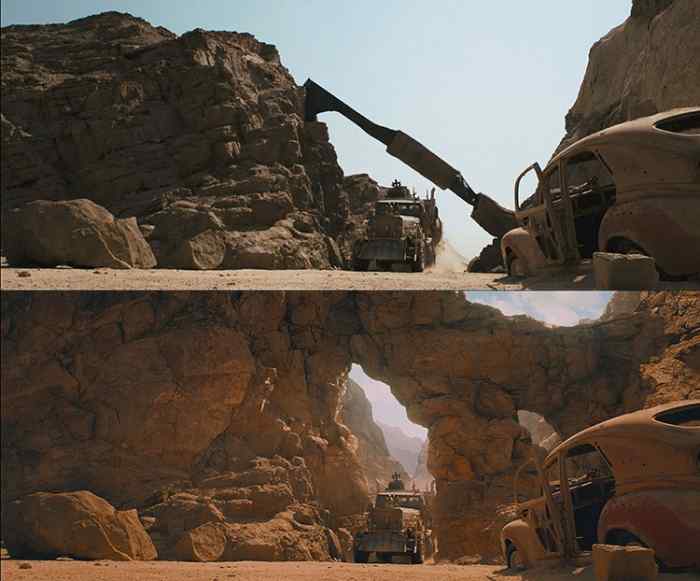
Iloura heightened and narrowed the canyon, providing the overhang they would later blow up. Not only is collapsing the canyon dangerous in real life, it is simply impractical (pun intended). Still, Miller and Jackson wanted a realistic look. Jackson recounts that “there was an old quarry in the area where we were working, and I asked if it might be possible to actually blow up a bit of the quarry. We asked the owner and he said, ‘Yeah sure.’ So we staked out the bit we wanted to blow up and we put cameras on the ground and we’d already matched the angles – and we blew it up. Then we comp’d it in.”
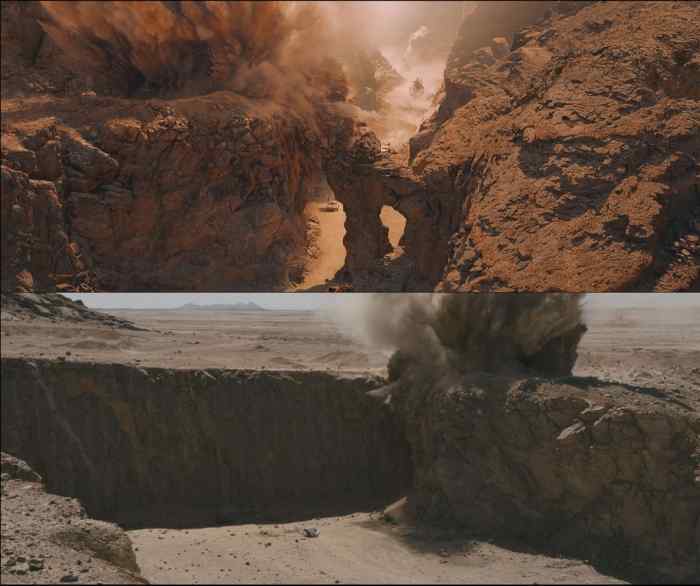
Bottom: the original footage of blowing up the quarry.
Most effects in Fury Road were done this way—real footage composited into a scene with CG embellishments. Tom Wood, visual effects supervisor, assures audiences that “we were not comp’ing or changing any elements of the actual explosion.” For actors’ safety, they were often filmed on green screen and added into a shot as well. The same goes for crowds, though not necessarily for safety reasons. It is easier to hire a couple hundred extras to be near the action and fill in thousands more digitally than actually gather thousands in the desert. Wood explains how “they had shot about 150 extras and we extended those to 30,000 with crowd sims.” Legions of tired, poor, huddled masses yearning to drink free were duplicated and layered into the crowds around the Citadel.
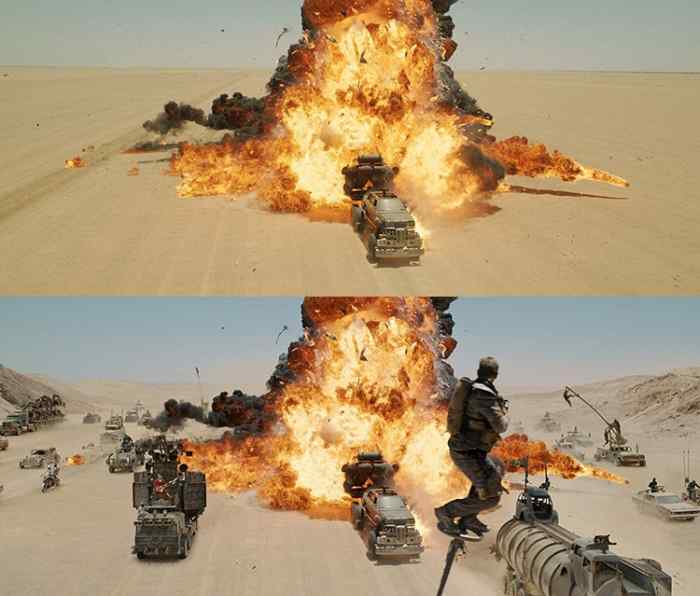
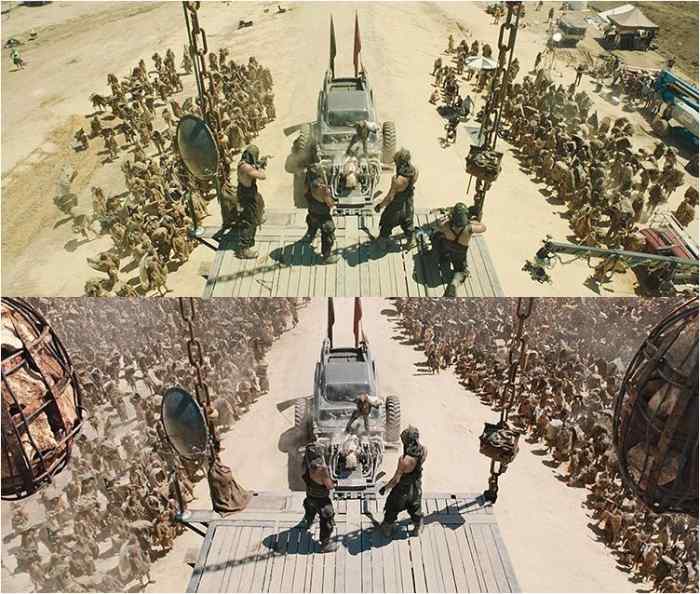
Before Furiosa’s expedition embarks, Immortan Joe — leader of this dystopian desertscape — oh-so-graciously opens the gates on a waterfall to quench his subjects’ thirst. Though it is a meager sprinkling in comparison to how many are gathered below, it presented yet another hurdle that the effects team gracefully cleared:
The water flow from the pipes made use of a Houdini simulation [3D animation software] for wide shots, with some practical water on set. “They had practical rain machines on set in front of their very small piece of rock face,” describes Wood. “That sprayed out more than a mist — it was a rain. There was also some pouring water where it splashes on some rocks. Everything above that was VFX.” (fxguide)
The Citadel itself was a feat to realize on-screen. Not surprisingly, it is a full CG environment. Fxguide notes that “the Citadel location was produced via a combination of principal photography in Namibia, shooting in Sydney and visual effects work from Iloura informed by actual rock cliffs photographed in Australia and re-worked using photogrammetry.” In other words, Australian rock outcroppings were recreated on computers, layered into the Namibian desert, whereupon actors on a set in Sydney were green-screened into the shot. Jackson says that he has “an absolute aversion to people painting rocks. I just always want to use real surfaces and textures and shape as much as we possibly can.” The more photorealistic the CGI, the better.
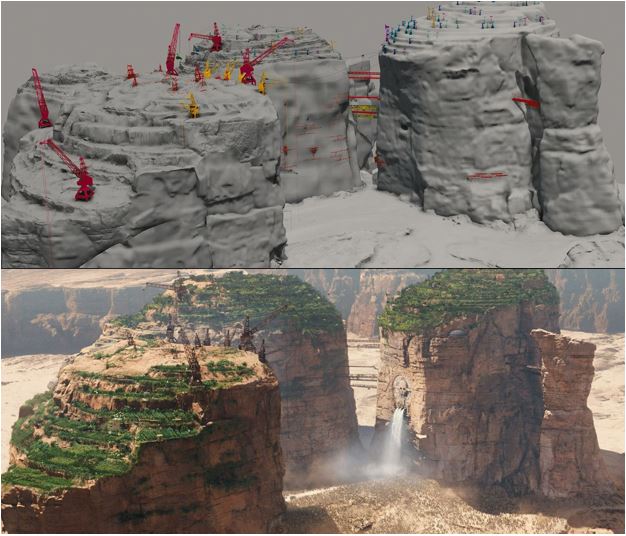
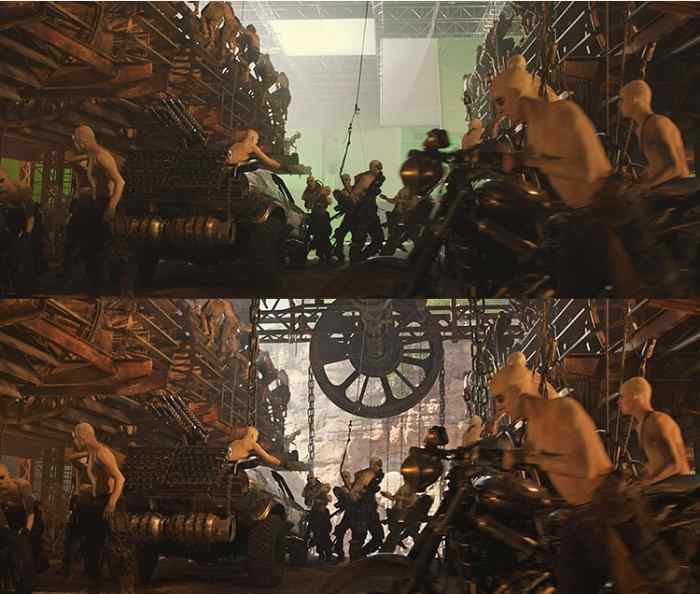
One of the most astounding features of the film is the massive storm roiling across the desert. Furiosa careens into its toxic dust clouds and lightning strikes to try to throw the pursuing posse of War Boys. Some things in this tempest which may seem CG are in fact live action, placed digitally via green screen.
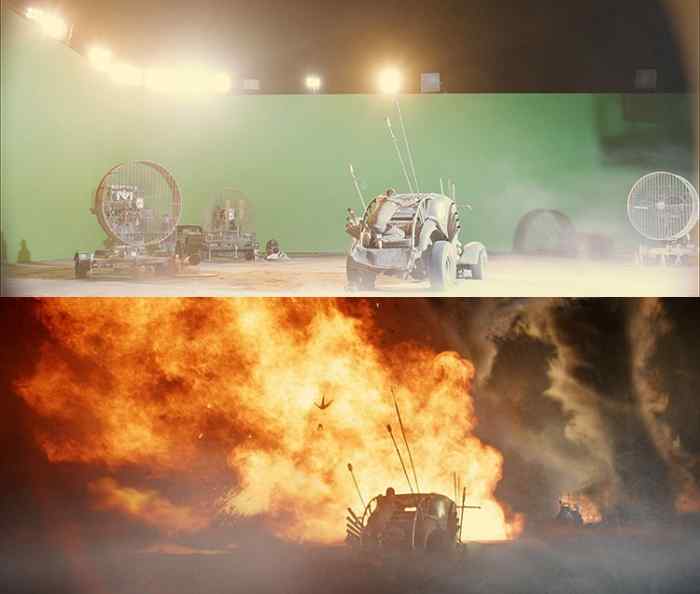
Although most of the sequence could have been done entirely in CGI, Jackson maintained Miller’s vision that practical reality trumps imitation. Not only do the vehicles look real, so do the camera movements.
You shoot the layout and vehicles and gradually everything might get replaced, except the camera and the positions of where things were. You may end up with nothing left of what was actually filmed, but the shot still inherits something real from the plate you shot originally. I still believe it’s worth doing for that reason. — Jackson
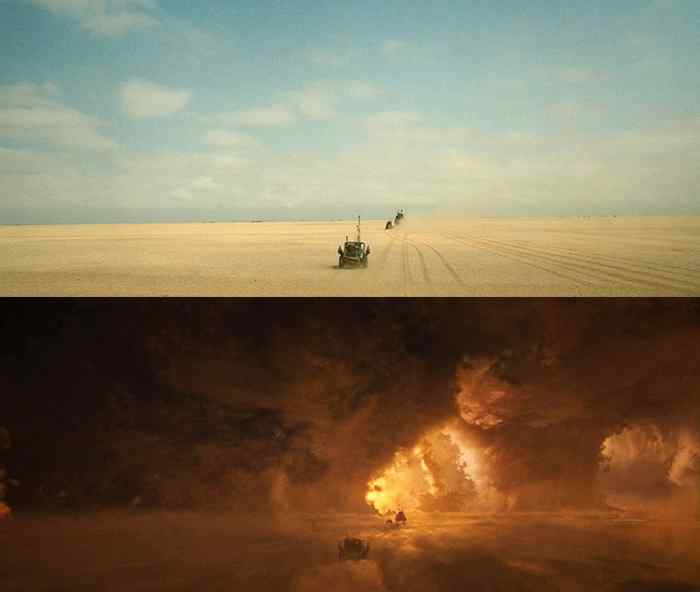
Obviously, the twisters in the storm had to be manufactured. They were created using massive fluid simulations, sucking up everything in their path. At one point there is a shot of a group of War Boys being flung from their vehicle into the spout, which is done entirely in CGI. Alternatively, Miller and his crew could have wired stuntmen and layered them in, but in this case “we’re so used to seeing what stuntmen do in these kinds of crashes. They will take a run and jump off a bounce board and fly through the air and circle their arms and pedal their legs — it’s an exaggerated performance,” Wood says. Ultimately, Iloura used the software Endorphin to create elaborate sims and key frame animation for the flying War Boys.
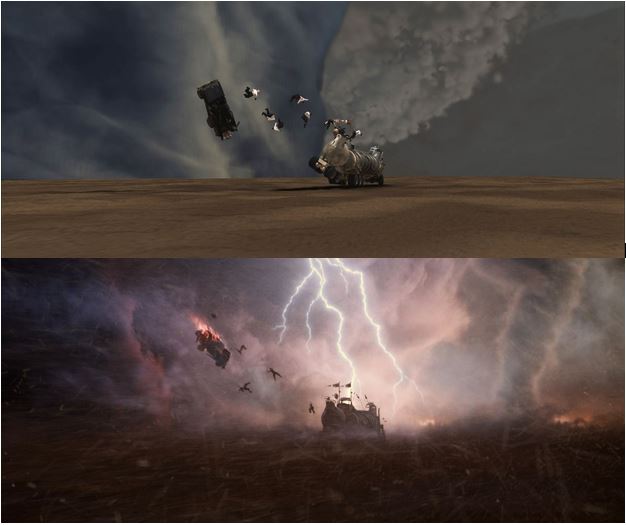
Bottom: Final frame.
A thorny task for the visual effects team was keeping light consistent. Dust presented a challenge; in footage, the light may have been shining on particles from a different angle than post-production would like. Jackson specifically filmed sand swirling in different patterns to add it in later. Wood expounds:
It was tricky because it was all shot in predominantly bright sunlight on a very flat empty piece of desert. We had dust kicked up from the car and they were all glinting and very directionally lit, which we had to suppress. Or we would track the vehicles and put CG replacements in with new directional lighting — or flashed from live to CG and back again, so we could have lightning flashing from all different directions and dust shadowing the cars that we couldn’t have on set.
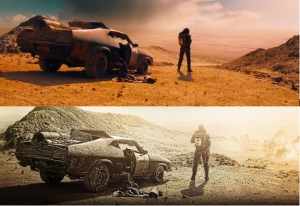
Bottom: Before coloring.
To make Fury Road aesthetically appealing, director of photography (DOP) John Seale and colorist Eric Whipp developed a conspicuous style. Miller, opposed to the usual “post-apocalyptic bleached look,” inspired the rich color palette used in the film. “We had two words in the back of our heads the whole time — graphic novel,” Whipp says. Notice how some photos in this article lack the vibrant saturation present in the movie? This was especially apparent in promotional material released prior to coloring.
In addition to imbuing the movie with a rich color scheme, the post-production team swapped out the skies in most shots. “Whenever we could we changed the sky — we just tried to make it as graphic as we could, just to avoid that bleached feel,” explains Whipp. Brighter? More clouds? No problem. Sky replacement also helped it stay consistent from shot to shot. The team filmed skies wherever they went, inserting them into scenes as they saw fit.
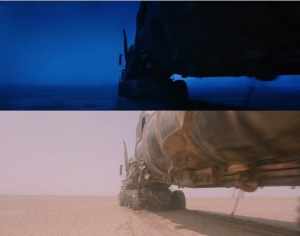
Bottom: Original overexposed daylight shot.
The War Rig drives through the night, but it is a night like none other. It is in no way photorealistic; filmed overexposed in daylight, it is turned a vivid, stylized blue. The team tried using a photorealistic night, which really did look like nighttime, but it was impossible to see the action in the darkness. Instead, they opted for inverting daytime. Everything is visible, there is more detail, noise is cut down, and shadows remain accentuated. If you watch closely, the scene begins darker and becomes brighter throughout. “It was just a way of getting into it, selling the idea of night, walking into darkness and your eyes are getting used to it and it plays a little brighter,” Whipp enlightens.
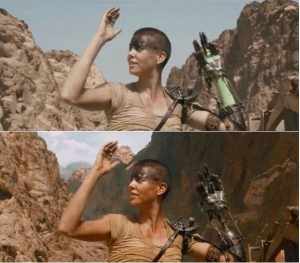
Bottom: The arm is edited out and replaced with a metal shaft.
It was certainly a herculean labor of love to pore over each frame of Fury Road. Most VFX efforts consisted of changing aspects of the environment — undoubtedly a colossal task, but that was not the extent of it. Furiosa has a prosthetic limb. Charlize Theron, the actress who plays her, does not. To pull off the illusion, Theron wore a green sleeve accompanied by the prosthetic apparatus. The VFX team simply edited out her arm and replaced it with a metal shaft in post-production. For the scene when Furiosa fights Max without her prosthesis, Theron simply wore the green sleeve and avoided using her left arm.
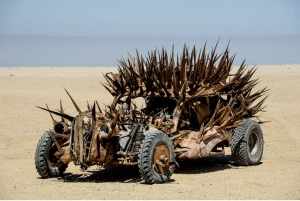
Fury Road is arguably one long car chase through an arid wasteland of grotesque characters, outlandish customs, and bizarre vehicles. The latter is a point of excitement for many, and absolutely adds to the fantastic nature of the film. However, no matter how surreal they may seem, all are functional modes of transportation. Colin Gibson, head production designer and art director, ensured that each vehicle “possess personalities as important as the leather-and-metal-clad maniacs who drive them.” For a breakdown of the cars, see this. Motorcycles are here.
Now for what you’ve all been waiting for. It’s time for the star of the show, the sensation of the Internet, the Doof Warrior! This blind, pajama-clad rocker shreds some serious metal, in every sense of the word. He hangs on bungees atop a speaker-laden rig (the Doof Wagon), blasting nonstop music for the War Boys and the audience. The rear of the Doof Wagon is home to coxswain-style Taiko drummers, but they don’t garner the same attention and admiration as does the Doof Warrior. Why is he so rad? Maybe because his double-necked guitar doubles as a flamethrower.
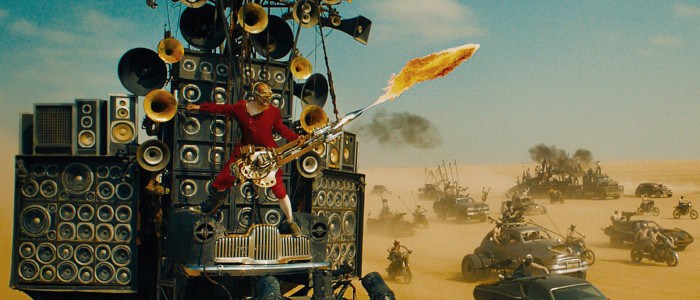
And, just like everything else in this movie, it is functional—both as a guitar and a flamethrower. During the final stretch of the car chase, as Max climbs aboard the Doof Wagon, the guitar is flung incredibly close to the camera. No, it was not done using CGI. Jackson recalls using good, old-fashioned physics:
It was all wires and flame throwers and had fuel lines that were broken and leaking fuel and various bits of wires dangling off. I just imagined that for real coming up to the camera and bouncing back. We set up a shoot for that where we hung the guitar from bungies on a cherry picker. I suggested that if you pull the guitar back and release it in exactly the same way it will always go back to the same spot. We released it and marked where it was going to and put a camera exactly there, so we could repeat that event and push the camera slightly closer.
The Doof Warrior’s guitar wasn’t the only thing that practically collided with the camera (pun intended). Jackson explains how the steering wheel was filmed differently, but with the same effect:
We shot that on a little gimbal spinning. In the end, George [Miller] wanted to push right into the mouth of the wheel, but the resolution wasn’t enough, so we tracked the action of the spinning wheel on the gimbal and I built a little rig to photograph that with a high res stills camera. So we matched the motion of the spinning one and did a really high res version – like stop motion. Pushing right into the mouth of the steering wheel was all a live action element.
Despite using CGI, Mad Max: Fury Road is still largely practical and stunt-based. Environment work, color grading, and green screen prevail amid less-frequent CG elements that would otherwise be impossible, such as the canyon, storm, and Citadel. In any case, the sheer monstrosity of the practical vehicles and devastating explosions is enough to reserve Fury Road a spot in the annals of history. As for which is better — CGI or practical effects — this film proves that the best has both.
For more in-depth information on the visual effects used in the film, visit fxguide here. Check out these YouTube videos for more peeks inside the process:
Works Cited
“Before and After Shots of ‘Mad Max: Fury Road’ Visual Effects Are Spectacular.” Doublemesh. 30 May 2015. Web. Link.
Elliott, Hannah. “Every Killer Car in Mad Max: Fury Road Explained.” Bloomberg Business. 12 May 2015. Link.
Failes, Ian. “A graphic tale: the visual effects of Mad Max: Fury Road.” Fxguide. 29 May 2015. Web. Link.
Hatch, Aaron. “Computer Generated Images: The Utilization in Hollywood Films.” The Artifice. 28 May 2015. Web. Link.
Lavrinc, Damon. “Can You I.D. All The Motorcycles In Mad Max?” Lanesplitter. 20 May 2015. Web. Link.
Marie, Bree. “Practical Effects vs CGI.” ThePeopleProject.com. Web. Link.
All images and clips copyright 2015 Warner Bros. Pictures.
What do you think? Leave a comment.











You have a fantastic article here. Mad Max: Fury Road might just be the golden example of how visual effects should be used in Hollywood films. It really is the perfect mix of creatively designed practical effects, and well polished CGI.
I agree! It is a fantastic blend of both, and it’s never overbearing. Thanks!
Glad someone took this topic. Very well done!
Thanks!
Another 20 years and we’ll all be able to experience Mad Max world for ourselves.
While this would – to a degree – be rad, I certainly hope not.
That’s so apocalyptical.
Great visuals, and the script I thought was brilliant – some fantastic lines in there, would love to get a copy. I’m an original MM fan, this one just blew me away.
I definitely wouldn’t mind watching it another couple (ten) times.
Fantastic choreography, it lays down the gauntlet to all those directors who have been relying on CGI to deliver their thrills. Peter Jackson, take heed.
So much choreo and timing was involved – it boggles my mind. Adding in the CGI/VFX made it that much better and thrilling to watch!
Awesome article, I knew when I was first reading it it would get a lot of praise. Fury Road marks the next step in action-adventure filmmaking. Hopefully, CGI overload will be replaced with a mix of practical and computer effects.
Thanks! Here’s to more films like Fury Road in the future!
One has to wonder to what extent does an CGI specialist can be referred to as an artist, when you compare CGI to hand crafted and/or pained set designs in older films.
From what I’ve seen of CGI, it is an intensely detail-oriented and time-consuming process. While it is done on computers instead of with physical materials, it still takes patience, talent, and passion. The result is something beautiful, just like traditional art; it’s just a different kind of art.
Interesting article! It’s nice to read behind the scenes, and how much thought is put into making the film!
It’s truly fascinating how much work this kind of thing is. Thanks!
cracking film.
Indeed!
I really enjoyed the film and thought it was well observed. I had only ever seen clips of the original Mad Max film and so I only had vague sense for what the films were about: a vehicle specialist ex-cop fighting for peace but turns to revenge in a violent dystopian Australia of the future. I was wondering if this was a sequel or equal, but it didn’t matter. Max did seem a bit ‘mad’ and raw so it lived up to the title. I thought the action sequences were enthralling but the unexpected thing was for once in a very long time I actually gave a shit about what was going to happen. The plot was simple but that didn’t seem to matter much to me. Perfect popcorn movie.
Great observations. I hate to admit that I’ve never seen any other Mad Max movies, but this seemed pretty stand-alone.
Many modern action movies are like watching someone play Xbox. But this is real – the action anyway. First pure action movie I’ve enjoyed in a long while.
Glad you enjoyed it!
It certainly takes visuals and stunts to a new level. Didn’t excite me overall, but held my attention.
It’s not for everyone, but at least you were entertained!
Hardy missed the target here. Something went wrong with his interpretation of the character.
Interesting – I can’t really comment on this because I haven’t seen Mel Gibson’s portrayal.
Visually it was full of imagination , Miller wet all out and it’s great to see the effort put into this.
Glad you enjoyed it!
Marvelous Erica! Thank you for the visual comparison it really allows the reader to experience your text, and it does make me want to see the film.
Thanks! Happy to bring Fury Road into your life!
I had always been aware there has been indeed some CGI in Mad Max applied, but the only instances in my personal viewing experience of Conspicuous CGI was the flying guitar and wheel. And for me to only tally of “two” of those instances is astounding for me these days.
We will always acclaim this film precisely because of its practical effects and how we notice that they are AUTHENTIC right on the screen (the stunts particularly). But do not forget the skillfully sleight of some CGI to give the scene the right scope and atmosphere.
I think it’s fabulous that the only things you thought were CG were in fact practical (green screen)! I thought they were CG, too, but I soon found out otherwise.
how about a movie where the future is actually quite nice?
That’s no fun! (But it would be a nice reality.)
Oh, wow — this is such a good movie (i think I’ve seen it four times, maybe five), and your article really accentuated that! Like, I went into this very warily, but I was really pleased by what I read. Frankly, I love the fact that this flick used a combo of CGI ad practical effects — mostly because I love how gorgeous Fury Road was. I mean, I can’t be the only one getting sick of dark, grimy dystopians and teal and orange sci fis, right?
But the practical effects felt very, very real, and I think that really added to the overall feel of the film – it made you care more about what was happening because it felt like there was real danger involved, not just awesome explosions and stuff.
Fantastic work!
Absolutely – I love the colorfulness, which makes it seem so unreal, but also the very realistic stunts. Thanks for the glowing comment!
Fabulous. Thanks for the resources.
Thanks – glad you found them useful!
Your article is really interesting. I knew George Miller was adamant about using real elements in the film, but I didn’t realize how much work he did to ensure that the real and CGI elements came together to create the right kind of atmosphere in the film.
Thanks! He really got the right mix.
I adored Mad Max: Fury Road and this was an incredibly interesting breakdown. I especially appreciated the photograph comparisons between the real shot and the CGI’d shot. I was trying to explain to others about how much practical shots were used in the movie, and I’ll have to direct them to this explanation.
Glad you found this helpful!